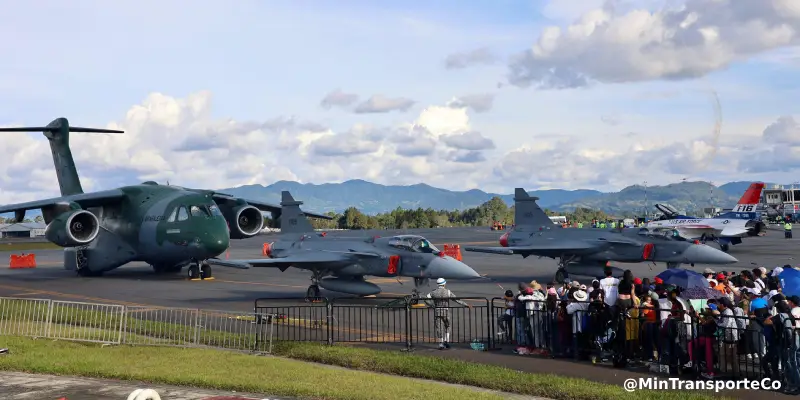The International Aeronautical and Space Fair, F-AIR 2025, concluded its twelfth edition with a resounding message: Colombia is ready to lead the aeronautical and aerospace transformation in the region. From July 9 to 13, the José María Córdova International Airport became the epicenter of five intense days of innovation, exhibitions, strategic agreements, and air shows that captivated 58,862 national and international visitors.
Organized by the Civil Aviation Authority and the Colombian Aerospace Force, with Corferias as the logistics operator, the event successfully attracted over 230 aerospace sector companies from various countries, reaffirming its status as one of Latin America’s most significant gatherings.
Key Figures
- Visitors: 58,862
- Participating companies: 230
– National: 76%
– From Antioquia: 45%
– International: 24%
- Successful business meetings: 516
- Total fairground area: 90,000 m²
- Commercial exhibition area: 7,200 m²
- Public seating capacity: 5,000 spaces
- Aircraft on static display: over 30
These figures reflect the fair’s direct impact on energizing the sector, both in terms of visibility and commercial opportunities.
→ JetSMART Launches New Cali–San Andrés Route
Sweden: A Strategic Ally in Innovation and Defense
As the guest country of honor, Sweden showcased the best of its aeronautical technology with the presentation of its Gripen fighters, icons of modern combat aviation. This participation not only added spectacle and knowledge but also strengthened bilateral cooperation with Colombia in key areas such as innovation, defense, and sustainability.
Colombia Bets on Sustainable Aviation
One of the most significant announcements was Colombia’s adherence to the ICAO ACT-SAF program, which promotes the use of sustainable aviation fuels (SAF). Additional initiatives included:
The ‘SAF Vuela’ agreement between Ecopetrol and the Civil Aviation Authority to lead national SAF production.
Memoranda of understanding with Aruba, LATAM, and Fedepalma, positioning the country as a regional leader in decarbonizing air transport.
International Alliances to Strengthen Capabilities
During the fair, multiple strategic agreements and meetings were solidified:
- United Kingdom: Cooperation on new SAF raw materials and tourism development in San Andrés and Tolú.
- EASA (European Union Aviation Safety Agency): Continued collaboration on operational safety.
- SAAB (Sweden): Pilot project for a digital tower in Villavicencio.
- Airbus: Potential advancements in air ambulances, sustainability, and the establishment of a maintenance center (MRO) in Colombia.
Additionally, progress was made in strengthening unmanned systems (UAS), with clear intentions to modernize national regulations and facilitate their application in agriculture, surveillance, logistics, and emergency response.
International Congress and New Firefighting Helicopters
As part of F-AIR, the Colombian Aerospace Force organized the First International Congress of Aeronautical Logistics Chiefs of the Americas, with representatives from nine countries: Argentina, Brazil, Chile, Ecuador, the United States, Mexico, Peru, the Dominican Republic, and Uruguay. This was a key space for technical exchange in maintenance, logistics, and materials.
Furthermore, a $150 billion agreement was signed between the FAC and the National Unit for Disaster Risk Management to acquire two Firehawk helicopters, specialized in firefighting, aeromedical evacuations, and rescue missions.
Air Shows
The excitement was undeniable. High-risk maneuvers performed by the Texan Squadron, the Kfir Darts, and the Arpía 51 aerobatic team left attendees breathless. The Águila de Gules parachute team and The Wings of Blue (USA) also stood out, jumping from 10,000 feet with precision and patriotism.
Among the major international attractions were the F-39 Gripen and the KC 390 from the Brazilian Air Force, as well as the impressive Viper Demo Team with their F-16s from the United States Air Force.
Commitment to Technological and Social Development
The Colombian Aerospace Force’s exhibits offered a glimpse into the future. The FAC’s Technology Development Center shared its advancements in innovation and the benefits of its space assets, essential for strengthening national sovereignty. Additionally, socially focused projects were highlighted, reaffirming the institution’s commitment to the country.
F-AIR 2025 was not only a success in terms of attendance and agreements but also made it clear that Colombia is steadily advancing toward a more modern, clean, and safe aviation industry. With strategic alliances, cutting-edge technology, and a clear vision for sustainability, the country is solidifying its role as a key player in Latin America’s aeronautical and aerospace landscape.
Related Topics
Air Europa Announces New Non-Stop Route Between Madrid and Johannesburg Starting June 2026
Lufthansa Receives Its Boeing 787-9 in Frankfurt with Special Livery for Airline’s Centennial
Finnair Announces Flights to Melbourne via Bangkok Starting October 2026
EASA Orders Inspections on Airbus A320 Aircraft for Possible Defective Panels
Plataforma Informativa de Aviación Comercial con 13 años de trayectoria.
